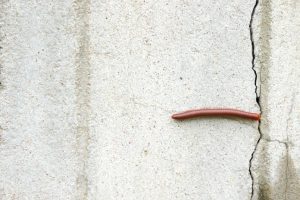MILLIPEDE CONTROL

Millipedes are a common pest in the New Jersey area. They do not leave many signs of an infestation. Usually, the only way to know you have millipedes is by seeing them scramble from one bit of shelter to the next.
If you suspect you have an infestation, look for areas that contain material they may want to eat, including mulch, leaves, firewood, and other plant material in various states of decomposition.
Not sure if you have millipedes at home? Or maybe you want to learn more about how millipede control works. Check out the following information to clarify some questions you may have.
Library Shortcuts
- What are millipedes?
- Why do I have millipedes in my home?
- Are millipedes harmful?
- What is the difference between millipedes and centipedes?
- Are millipedes dangerous?
- Tips for property owners
What are millipedes?
Millipedes found in the New Jersey area are small, black and brown in color, and have segmented, worm-like bodies, although they aren’t worms at all. Millipedes are actually arthropods. The name “millipede” comes from Latin origin, meaning “a thousand feet.” It’s a common misconception that millipedes have 1,000 legs because there have never been any recorded cases of millipedes reaching that amount. Millipedes have between 40-400 pairs of legs depending on the species, of which there are about 10,000. Millipedes are slow-moving and tend to curl up into a spiral when disturbed, releasing an unpleasant scent.
Why do I have millipedes in my home?
Millipedes feed on decaying plant matter and prefer to live where they can find high levels of moisture and protection. Ideal living spaces include under rocks, mulch beds, flowerbeds, and gardens. You may see them in your home when it’s too dry or hot outside and your basement provides significant moisture.
Are millipedes harmful?
Millipedes are only a problem if their presence bothers you. They are entirely harmless to humans, do not spread disease, infest food, or cause any damage. Because they thrive outdoors, millipedes cannot reproduce indoors and will quickly die if they can’t find their way back outside.
What is the difference between millipedes and centipedes?
This is one of the most common questions that people ask about millipedes. Millipedes and centipedes are both arthropods that have segmented bodies and a large number of legs. Both insects are commonly found in New Jersey and surrounding areas, although you’re much more likely to see a centipede in your home than a millipede.
| MILLIPEDE | CENTIPEDE | |
|---|---|---|
| LEGS | 40-400 pairs | 15-177 body segments which typically have one pair of legs each |
| SIZE | 1-2 Inches long | 1/8-6 inches long |
| COLOR | Blackish brown | Varies. Common house centipedes are yellow and dark brown. |
| DIET | Decaying wood, decaying or dead plant matter, and occasionally decomposing animals | Spiders, crickets, ants, cockroaches, silverfish, other small insects |
| MOVEMENT | Slow, curls up when in danger | Rapid spurts |


Are millipedes dangerous?
Millipedes do not bite or sting. As a defense mechanism, millipedes will curl up and release an unpleasant smell. They are not dangerous, wood-destroying, poisonous, or a threat to your pets, food, or possessions. If you see millipedes in your home, don’t be alarmed.
Tips for property owners
Millipedes can be controlled by sealing cracks and crevices that serve as entry points and keeping vegetation and moisture of any sort away from the foundation of your home. Millipedes aren’t very big, so they don’t need a large hole to enter. After heavy rains, it’s especially likely that millipedes will be pushed into your home if they find an entry point.
Dry or hot weather creates an uncomfortable environment for millipedes, so they may be drawn into your home if you have water damage or humidity in your basement or garage. Ensure that moisture is kept away from the foundation by making sure gutters function correctly and all leaks are repaired. Millipedes need plant matter to survive, which is not something that’s readily available in your home. Simply vacuum them up as you see them because they will die in 24-48 hours indoors.
Finding millipedes in your home could be a sign of water damage. Examine your home and repair problem spots. Lastly, you can keep plant life, stones, boxes, etc. away from the foundation of your home to make the area less conducive to harboring millipedes. If you follow all of these tips, you’ll also be taking proactive steps to prevent other common basement pests such as spiders, crickets, silverfish, and centipedes.

Want a Free Estimate?
Need to Schedule Service?
Have a Questions?
WHAT WILL WE DO?
Our millipede control process typically consists of the following stages:
- Confirm or discard the existence of millipedes in your home through an inspection.
- Identify the factors that may be causing and contributing to the infestation.
- Offer pest control programs to get the problem under control.
- Treat the existing millipede population and prevent future infestations.
What our clients are saying
Our Partners and Awards
Service area
New Jersey:
Ocean County
Essex County
Passaic County
Morris County
Hudson County
Bergen County









